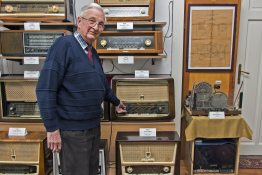Not an idea out of the air – Interview with Dr Rita Somogyi, winner of the Transport Innovation Award
A young Hungarian engineer, Dr. Rita Somogyi, and her team have now brought a new and precise solution to the field of GPS-based support for aviation security. Aviation has changed enormously from Icarus in Greek mythology to the present day! The progress is unstoppable, and now a Hungarian woman has contributed to it.

Dr. Rita Somogyi has already had an exemplary professional career from a young age: in addition to her training as a transport engineer, she completed the Budapest technical University's English language translator and interpreter training and then obtained the faculty's diploma of economic engineer. At the age of only 30, he obtained a Ph.D. in transport sciences. He is currently teaching at the university, raising two school-age children, and working in the industry.
In your spare time, you read thrillers, you enjoy drawing and you often stand over the stove in the kitchen. This year you graduated as a mental health specialist from Semmelweis University. Why did you feel this necessary when you already have an engineering degree and a Ph.D.?
“Initially it was just a hobby because I am interested in the psychology of events. Mental health training gives you a basic knowledge of how people work, how to accept and understand them. Among other things, it gave me an insight into how a healthy soul works, what its deviations can be, and what normative - that is, unavoidable - crises we encounter in the course of our lives. It would not be bad if, in the longer term, this knowledge could be made part of the curriculum in secondary schools. In fact, emotional intelligence is indispensable to making one’s way in life. I can also see this in relation to the teaching of university students: there are brilliant intellects who, despite being geniuses, are not paired by the kind of character insight and communication skills with which they can realize their ideas in practice and with the assistance of their colleagues, in which case their talent is easily wasted. In relation to the prize, I consider it very important to emphasize that this acknowledgment is the result of teamwork, there was a need for the cooperation of numerous experts in order to realize this R&D project.
“As an engineer, as a rational person, it is very easy to fall into the trap of only paying attention to the results, to the data. A project manager is expected to deliver a given result within the designated timeline and on budget. Meanwhile, at the heart of this activity is paying attention to people, because human relationships are a web that carries the real content. If I hurt my colleagues, then after a while this net rips, and the results fall through. As far as I am concerned, good working relations represent the greatest acknowledgment; good work carried out jointly is its own reward.”
Was it difficult to prove yourself as a young woman in the world of air transport?
“During my career I felt that I was not taken sufficiently seriously perhaps twice. These situations cannot be resolved in a couple of minutes, but decisive communication and taking the task seriously always help establish mutual respect.”
How have you managed to establish a healthy balance between career and family?
“This question arises in the life of a man as well, but maybe with them perhaps nobody is surprised if they choose work when there is a clash of priorities. In the short term, I reckon presence is most important. Wherever I am is where I try to be one hundred percent. When I'm with the children, I pay attention to them, consciously using the Rogersian mindfulness I learned at Semmelweis University. When I am working, I am fully engaged with that. In the long term, I believe that everything has its own time. For example, that is why I consciously had children before the period of building my career. Then I was working part-time for a long time and I only turned to my work more actively when my younger son started attending kindergarten.
“In fact, I saw the most amazing solution to this issue with an acquaintance of mine who lives in Luxemburg. In Western Europe, one can only stay at home with the baby for three or four months; the infant then has to be put into a creche. This couple I know had an idea that they would both take on part-time, 4-hour jobs so they could both stay with the baby, switching with each other, which is a truly creative solution allowing the parents to spend time with the child, meanwhile, both are able to keep up to speed with their respective professions.
“Staying at home with the child is, professionally speaking, definitely a sacrifice: the woman will have a 3-6-9-year gap in her CV, which we have to accept. I trust that more and more employers will realize the qualities that mothers acquire during these years. In terms of logistics, organizational, and efficiency matters – I am able to state categorically – bringing up one, two or three children can be comparable with the impact of the most renowned project management training.”
For more than 20 years, the business weekly Figyelő has compiled an annual listing of the most successful enterprises. In the past two years, with the collaboration of Nemzeti Útdíj Szolgáltató Zrt., outstanding innovative solutions in the transport industry have received a special prize. This year, Dr. Rita Somogyi, innovation development engineer of HungaroControl, collected the Transport Innovation Prize. Rita and her team’s development is GPS-based support for air transport, performance-based navigation (PBN), that can open a new era in light aircraft aviation in Hungary.
GPS (or satellite positioning system) has been used for nearly twenty years in ground transport. Why hasn't it been used more extensively in aviation until now?
“Because it is only in the past few years that the part-satellite EGNOS system covering Hungary, which can guarantee the reliability of GPS signals, has been built out. You should visualize it in this way: when driving in the car along the embankment in the city, it appears on the screen that we are actually driving in the Danube. This is caused by slight inaccuracies in the GPS signals. This is no big deal when one is on land because by looking around, it is obvious that we are not driving on the water. However, in aviation, the pilot cannot be assured about accuracy purely from sight. For a long time, we couldn’t count on aircraft sinking below an altitude of 200 feet on a GPS basis. This means that a light aircraft pilot is navigated towards the ground by this GPS-based solution until approximately 60 meters above ground level, from where he or she has to be able to see the runway and thus effect the landing. Satellite landing systems allow aircraft to arrive at the runway not necessarily along a fixed, defined straight path but, with the help of GPS, they can do it on a pathway that is curved or otherwise, which is extremely useful in the case of an approach with difficult terrain. In practice, we now have the best satellite navigation systems. These results are the outcome of more than three years’ work by over 20 people. These procedures will be first used at airports of Békéscsaba, Debrecen, Győr-Pér, Kecskemét, Nyíregyháza, Pápa, Pécs, Sármellék, Szolnok and Szeged.”







